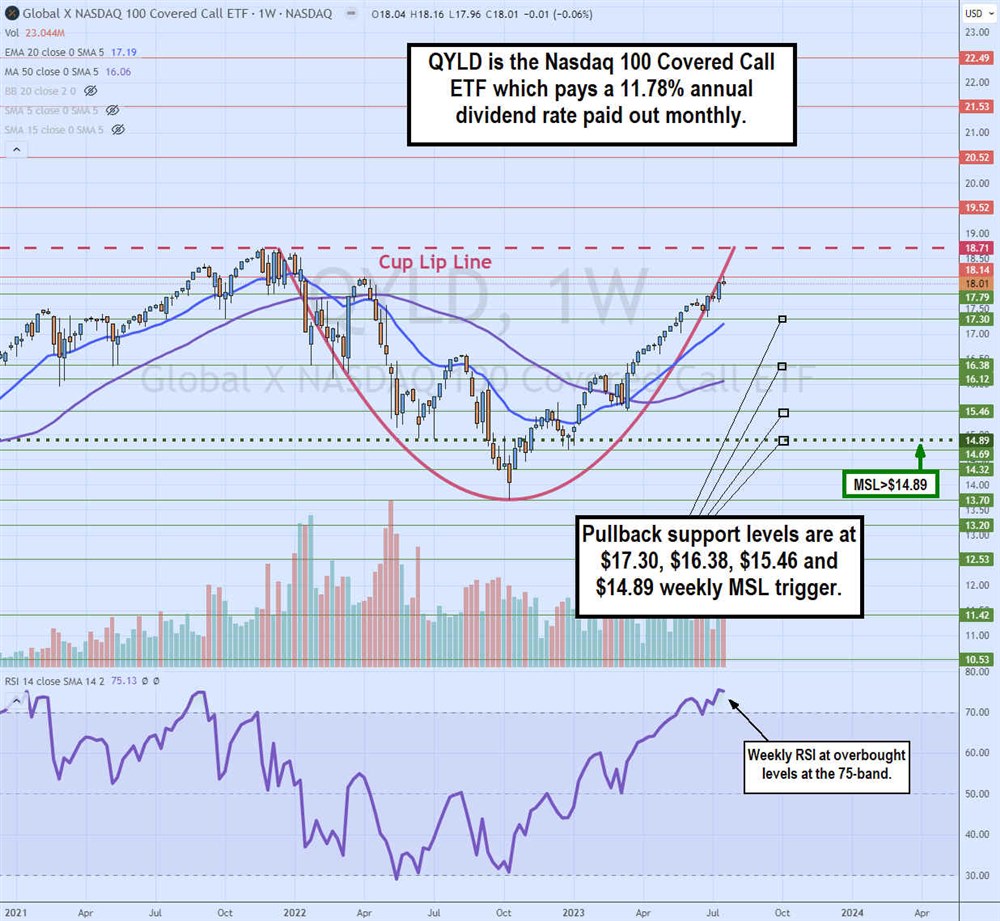As the Nasdaq 100 Invesco QQQ ETF NASDAQ: QQQ closes on all-time highs, investors may hesitate to chase it higher. Dividend yields shrink as the underlying share prices rise, making entering dividend stocks at these lofty prices even costlier. What's an income investor to do?
Consider taking a look at a covered call strategy. In a rising market, covered calls help maximize income while gaining from stock appreciation. The covered call premiums and dividend payments help to buffer price declines on pullbacks. This can be done manually by writing covered calls on the QQQs after purchasing them, but it can be costly to buy enough QQQ shares at $375.63, and you would also incur commission costs for the options trade.
It also requires more active management to select the best strike prices carefully. The alternative is to leave it to the pros and consider investing in the Global X Nasdaq 100 Covered Call ETF NASDAQ: QYLD, especially if you're looking for a passive income strategy. The QYLD has great liquidity, trading over six million shares daily, and pays a 10.83% annual dividend yield or $1.85, paid out every month. Consider that the QQQ pays 0.57% or $2.15 quarterly.
It costs less capital to invest, and dividends get paid out monthly, and capital appreciation with some downside protection with the premiums it collects selling calls.
Covered Call Strategy
A covered call strategy involves purchasing a stock and then selling the call option, the right for someone else to buy your stock at a strike price in the future. It comprises two transactions, buy the stock and sell the option. Most options contracts expire worthless, indicating most people lose money when buying directional options contracts.
It's the sellers of those contracts that tend to make money. Sell a call option is like collecting rent for owning a stock. You keep the premium regardless and can make an additional profit if the stock gets called away or the option gets exercised at a higher price than what you paid.
Best in Rising Markets
A covered call strategy is best utilized in a rising market enabling the investor to collect premium (income) and price appreciation (growth) if the stock rises through the selected strike price. If the underlying stock also pays dividends, it's a win-win-win.
But Can Weather Falling Markets
In a falling market, the investor would still collect the premium and dividend but potentially lose value on the falling stock price. The premium and divided acts as a buffer, which helps cover some losses instead of just owning the Q and getting hit with losses on the way down. The QYLD is less volatile than the QQQ, making income investors slightly more confident. Conversely, a covered call strategy has limited upside due to the nature of writing covered calls. The upside gains are capped at the strike price.
QYLD dividend yields and history are at MarketBeat.

Weekly Cup Pattern
The weekly QYLD chart is closing in on a cup pattern. The cup lip line started after peaking at $18.71 in December 2021 as it proceeded to sell off with the markets to a low of $13.70 by October 2022. The weekly market structure low (MSL) breakout formed on the $14.89 trigger to stage a rally into 2023 as the weekly relative strength index (RSI) bounced off the 30-band.
QYLD has had a slow and steady grind with small green candles since March 2023. It's still below the cup lip line at $18.71, but trying to close in to complete the cup. If it rejects there, it can form a handle on the pullback and bounce for a potential weekly cup and handle breakout.
The weekly RSI is currently in very overbought territory around the 75-band. Pullback support levels are $17.30, $16.38, $15.46 and $14.89 weekly MSL trigger.
Before you consider Global X Nasdaq 100 Covered Call ETF, you'll want to hear this.
MarketBeat keeps track of Wall Street's top-rated and best performing research analysts and the stocks they recommend to their clients on a daily basis. MarketBeat has identified the five stocks that top analysts are quietly whispering to their clients to buy now before the broader market catches on... and Global X Nasdaq 100 Covered Call ETF wasn't on the list.
While Global X Nasdaq 100 Covered Call ETF currently has a Hold rating among analysts, top-rated analysts believe these five stocks are better buys.
View The Five Stocks Here
Today, we are inviting you to take a free peek at our proprietary, exclusive, and up-to-the-minute list of 20 stocks that Wall Street's top analysts hate.
Many of these appear to have good fundamentals and might seem like okay investments, but something is wrong. Analysts smell something seriously rotten about these companies. These are true "Strong Sell" stocks.
Get This Free Report
Like this article? Share it with a colleague.
Link copied to clipboard.